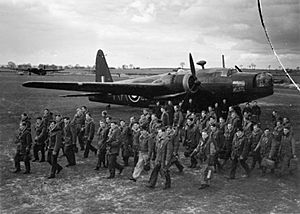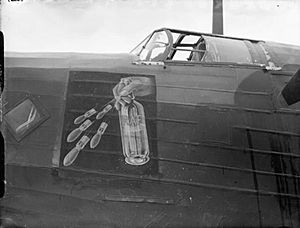No. 75 Squadron RAF facts for kids
Quick facts for kids No. 75 (New Zealand) Squadron RAF |
|
|---|---|
| Active | 1 October 1916 – 13 June 1919 15 March 1937 – 4 April 1940 4 April 1940 – 15 October 1945 |
| Country | |
| Allegiance | |
| Branch | |
| Nickname(s) | New Zealand |
| Motto(s) | Māori: Ake ake kia kaha ("For ever and ever be strong") |
| Insignia | |
| Squadron Badge | In front of two mining hammers in saltire, a hei-tiki |
| Squadron Codes | FO Oct 1938 – Sep 1939 AA (Apr 1940 – Oct 1945) JN (Feb 1943 – Oct 1945, 'C' Flt only) |
No. 75 Squadron was a special unit of the Royal Air Force (RAF), which is Britain's air force. It flew bomber planes during World War II. What makes it unique is that in 1945, it was given to the Royal New Zealand Air Force (RNZAF). This is the only time in the RAF's history that a squadron was given to another country's air force.
Contents
Early Days: World War I and Home Defence
No. 75 Squadron first started on October 1, 1916. Back then, it was part of the Royal Flying Corps, which was Britain's air force during World War I. Its main job was "Home Defence." This meant protecting Britain from enemy air attacks.
The squadron was based in different places like Goldington and Elmswell. They flew planes like the BE2c and later the FE2b. Even though they were ready to fight, the pilots never actually met any enemy planes in battle. The squadron was eventually closed down on June 13, 1919, without seeing any action.
Reforming as a Bomber Squadron in 1937
The squadron was brought back to life on March 15, 1937. This time, it was called No. 75 (Bomber) Squadron. It was part of a plan to make the RAF bigger.
They started at RAF Driffield in Yorkshire. Their first planes were Vickers Virginia bombers and Avro Ansons. Later, they got bigger planes called Handley Page Harrows. These were long-range bombers.
By 1939, No. 75 Squadron became a training unit. This meant they helped train new pilots for RAF Bomber Command. They moved to RAF Stradishall and started using Vickers Wellington Mk1 planes. On April 4, 1940, the squadron was absorbed into a training group and stopped existing as a separate unit.
The New Zealand Squadron is Born
In 1938, the New Zealand government ordered 30 Vickers Wellington Mk1C bombers. New Zealand aircrew were sent to England to learn how to fly these new planes. Their plan was to fly the planes back to New Zealand.
These airmen were known as "The New Zealand Squadron." When Britain declared war on Germany, New Zealand decided to let these airmen and their planes help the RAF. On April 4, 1940, the British Air Ministry gave them the old No. 75 Squadron number. This meant the New Zealand airmen could stay together as an active unit in the RAF.
World War II: New Zealand Crews in Action
On April 4, 1940, "The New Zealand Squadron" officially became No. 75 (NZ) Squadron. This was the first squadron from a Commonwealth country to be formed in World War II. Even though it had "NZ" in its name, the RAF controlled and supplied the squadron until the war ended.
No. 75 (NZ) Squadron flew many missions over countries like France, Norway, Belgium, and Germany. Their plane codes, "AA," became very well known. Later, they also used "JN" for some of their planes.
They started with Vickers Wellingtons, then moved to Short Stirlings, and finally Avro Lancasters in 1944. These were powerful heavy bombers. By the end of the war, all the squadron's personnel were New Zealanders. When Japan surrendered in August 1945, the squadron was getting ready to fly new Avro Lincoln planes to the Far East. However, the war ended, and the squadron was disbanded. The New Zealanders slowly returned home.
Here are the bases and aircraft used by No. 75 Squadron during its time as a bomber unit:
| From | To | Base | Aircraft |
|---|---|---|---|
| Mar 1937 | Jul 1938 | RAF Driffield | Anson Mk.I, Virginia Mk.X |
| Jul 1938 | Jul 1939 | RAF Honington | Anson Mk.I, Harrow Mks.I, II |
| Jul 1939 | Sep 1939 | RAF Stradishall | Anson Mk.I, Wellington Mk.I |
| Sep 1939 | Apr 1940 | RAF Harwell | Anson Mk.I, Wellington Mk.I |
| Apr 1940 | Aug 1942 | RAF Feltwell | Wellington Mks.I, Ia, Ic |
| Aug 1942 | Nov 1942 | RAF Mildenhall | Vickers Wellington Mks.Ia, Ic Short Stirling Mk.I |
| Nov 1942 | Jun 1943 | RAF Newmarket | Short Stirling Mk.I |
| Jun 1943 | Jul 1945 | RAF Mepal | Short Stirling Mks.I, III Lancaster Mks.I, III |
| Jul 1945 | Oct 1945 | RAF Spilsby | Lancaster Mks.I, III Lincoln Mk.II |
Transfer to the Royal New Zealand Air Force
In October 1946, Britain decided to thank New Zealand for the brave work of its aircrew. So, they officially transferred the squadron number, its badge, and its colours to the Royal New Zealand Air Force. This was a very special gift.
At that time, No. 2 Squadron RNZAF was getting rid of its Ventura bombers. So, it was disbanded and then renumbered as No. 75 Squadron RNZAF. This new squadron became a Fighter/Bomber unit. They received 50 de Havilland Mosquito planes that they flew all the way from Britain.
The RAF has never had a No. 75 Squadron since then. It remains the only RAF squadron ever given to a Commonwealth country by Britain. The squadron badge also went to New Zealand. It kept its RAF design, but with the Royal New Zealand Air Force name. This makes it a truly unique badge among all RNZAF badges.
Achievements and Legacy
No. 75 (NZ) Squadron was very active against Germany from 1940 until the end of the war in Europe. This squadron flew more missions than almost any other Allied heavy bomber squadron. They also dropped the second largest amount of bombs of any Allied squadron. Sadly, they also had the second highest number of casualties among all Allied squadrons.
A very brave act earned Sergeant J. A. Ward the Victoria Cross. This is the highest award for bravery in the Commonwealth. He climbed out onto the wing of his Wellington bomber during a mission over Europe to try and put out an engine fire. Even though the plane was badly damaged, it managed to return to base.
Today, a rebuilt Lancaster bomber in the Museum of Transport and Technology in Auckland, New Zealand, has the "AA" codes of a 75 (NZ) Squadron aircraft. This particular plane was never in combat. It was left in New Zealand by the French Navy and given to the people of New Zealand.
One of the most famous aircraft in 75 (NZ) Squadron was Lancaster NE181 (JN-M). It completed over 100 missions! Attempts were made to bring this plane back to New Zealand in 1945, but the government decided not to pay for it. All other surviving 75 (NZ) Squadron aircraft were taken apart for scrap metal in 1947–48.




